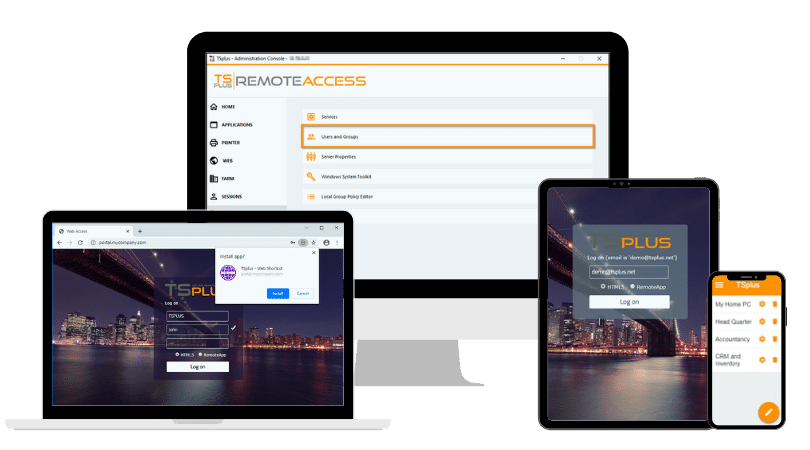)
)
How Can You Enable Remote Desktop?
Access Server Manager
Begin by accessing the Server Manager in Windows Server 2025, which is central to managing system settings and configurations.
Open Server Manager
Navigate through the Start menu to launch the Server Manager, your primary interface for adjusting server settings and roles.
Server Role Selection
Within the Server Manager dashboard, select 'Add roles and features' to initiate the configuration of Remote Desktop Services, which are essential for enabling remote access .
Configure Remote Desktop Services
Proper configuration of Remote Desktop Services involves several crucial components that ensure secure and efficient operation.
RD Gateway Configuration
Set up the RD Gateway to facilitate secure connections to your internal network from external sources. This component uses SSL encryption to safeguard data transmissions, making it an essential security measure.
RD Licensing Management
Manage client access licenses (CALs) through RD Licensing to ensure all connections are properly authorised and compliant with Microsoft's licensing agreements. This step is critical for legal and operational conformity.
RD Session Host Configuration
Adjust the settings for the RD Session Host to optimise the hosting of applications and desktops accessed by remote users. This setup is vital for providing a stable and responsive user experience.
Enable RDP on the Server
Enabling RDP is crucial for allowing Remote Desktop connections, which is the backbone of remote management.
System Properties Adjustment
Navigate to the 'Remote' tab in 'System Properties' and select 'Allow remote connections to this computer' to enable RDP connections.
Network Level Authentication
Activate Network Level Authentication (NLA) to add a layer of security during the authentication phase. NLA ensures that connections are not only secure but also authenticated at the highest level possible.
Enhancing Security and Accessibility
As you enable and configure Remote Desktop, consider employing advanced security settings such as configuring continuous access evaluation policies, which monitor and react to suspicious activities in real-time. These enhancements are not just about maintaining security; they also improve the usability and flexibility of your server environment, enabling it to support a diverse range of business needs effectively.
How Can You Configure Network Properties?
Adjust Firewall Settings
Ensuring that your firewall settings are meticulously configured is crucial for safeguarding your network against unauthorized access while enabling secure remote connections. Proper firewall management not only allows certain types of traffic, like Remote Desktop Protocol (RDP), but also defends against potential threats.
Add Firewall Rules
Start by adding specific inbound rules to permit RDP traffic, which generally operates over TCP port 3389. This setting is critical for allowing remote access while keeping unwanted traffic out.
Configure Advanced Settings
Beyond basic rule settings, configure advanced firewall features to enhance security. This includes establishing stringent monitoring rules that trigger alerts for any unusual activities, effectively creating a robust defence mechanism against potential intrusions.
Set Authentication Methods
Robust authentication methods are foundational to securing your network. These methods ensure that only authorised personnel can access systems, thereby preventing data breaches and other security threats.
Implement Multi-Factor Authentication
To strengthen security measures implement multi-factor authentication (MFA). This method requires users to provide two or more verification factors to gain access, significantly reducing the risk of unauthorized access due to compromised credentials.
Update Security Protocols
It's essential to continually update your security protocols to incorporate the latest advancements in encryption technology. Ensure that all remote connections use strong encryption protocols such as TLS 1.3, which provides confidentiality and integrity of data as it moves across the network.
Enhanced Network Security Measures
To further enhance security, consider deploying additional network protection measures such as intrusion detection systems (IDS) and intrusion prevention systems (IPS). These systems monitor network traffic for suspicious activities and can automatically respond to threats. Also, regularly updating firewall firmware and software can protect against vulnerabilities, keeping your network resilient against evolving cybersecurity threats.
How Can You Manage Remote Desktop Users?
Add Users and Groups
Controlling access to the server via Remote Desktop is critical for maintaining both security and operational integrity. Effective management of user access ensures that only authorised personnel can connect, which is fundamental in safeguarding sensitive information and systems.
User Access Permissions
Detail which users and groups are granted permission to connect through Remote Desktop in the 'Remote Desktop Users' settings. This setup is essential for regulating access based on user roles and responsibilities.
Group Policy Configuration
Leverage Group Policy to enforce further restrictions and manage permissions comprehensively. This can include settings that restrict file transfers, clipboard access, and other remote session features, thereby enhancing security during remote operations.
Configure User Permissions
Establishing detailed user permissions is vital to preventing unauthorized access and securing the network against potential breaches .
Assign Specific User Roles
Assign specific roles to users to tailor their access to the resources they need for their job functions. This helps in limiting access to sensitive information only to those who require it, thereby enhancing security protocols.
Manage Session Capabilities
Control and customize what users can do during their remote sessions. For instance, manage capabilities like clipboard sharing, printer redirection, and file transfers. Setting granular controls over these functions helps prevent data leaks and ensures that the remote desktop environment aligns with corporate security policies.
Advanced User Management Techniques
In addition to basic permission settings, consider implementing session timeout policies, audit logs, and tracking user activities to provide a comprehensive oversight of remote access Use tools and scripts to automate the provisioning and de-provisioning of user access based on job status or role changes, ensuring that access rights are always current with user needs and security requirements.
How Can You Optimize Performance?
Optimize Session Hosts
Optimising RD Session Hosts is crucial for ensuring that server resources are efficiently allocated, which directly impacts the overall performance and user experience.
Resource Allocation
Effectively manage resource distribution such as CPU, memory, and bandwidth across different sessions. Use dynamic resource allocation techniques to adjust resources based on real-time demands to maintain high performance levels even during peak times.
Performance Monitoring
Regularly monitor the performance of RD Session Hosts using real-time analytics tools. Identify and resolve any performance bottlenecks quickly, such as CPU spikes or memory leaks, to maintain smooth operation.
Monitor and Maintain
Continuous monitoring and proactive maintenance are key to ensuring that the Remote Desktop environment remains efficient, secure, and reliable.
Use Monitoring Tools
Utilise the advanced monitoring tools available in Windows Server 2025 to track performance metrics and user activities. These tools can help detect early signs of issues that could impact performance or security.
Scheduled Maintenance
Conduct regular maintenance tasks, including software updates, security patches, and system health checks. These are critical for maintaining the integrity and security of the RDS environment.
Advanced Optimization Strategies
To further enhance performance, consider implementing load balancing across multiple session hosts to distribute user loads more evenly. Additionally, optimise network settings to reduce latency for remote users, and consider using SSDs for faster data retrieval and improved session responsiveness.
TSplus Remote Access – An Enhanced RDP Solution
For organizations looking to extend their capabilities beyond what is available through standard RDS configurations, TSplus offers a robust solution that enhance security, provide additional customisation options, and offer comprehensive management features. Explore how TSplus can integrate with your Windows Server 2025 environment to optimise your remote desktop operations.
Conclusion
Enabling and configuring Remote Desktop on Windows Server 2025 can greatly enhance your organization's operational flexibility and responsiveness. By following these detailed steps, IT administrators can ensure a secure, efficient, and compliant remote desktop environment.

TSplus Remote Access Free Trial
Ultimate Citrix/RDS alternative for desktop/app access. Secure, cost-effective, on-premises/cloud














)
)
)